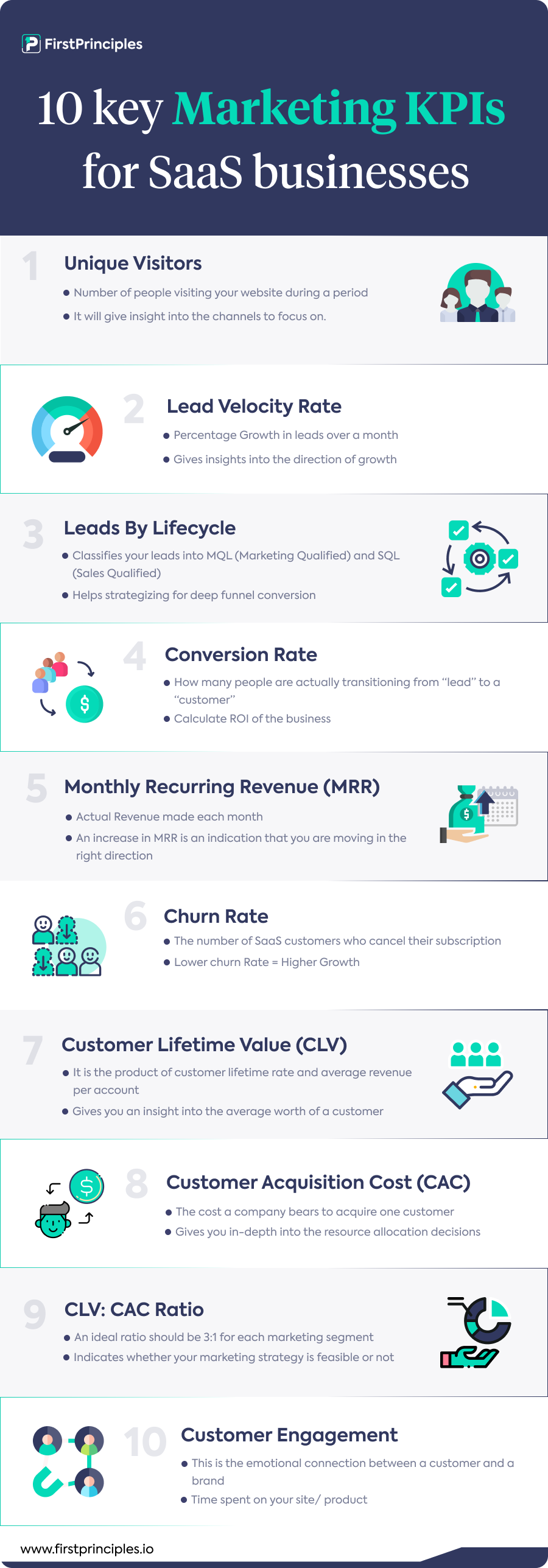
Home > 10 Key Marketing KPIs For SaaS Businesses You Should Track in 2023
Table of Contents
ToggleSaaS market space is growing exponentially, and keeping track of the SaaS marketing KPIs is imperative to boost your brand marketing efforts and performance. Consistent tracking of these KPIs further ensures that SaaS businesses generate high ROI.
There are hundreds of marketing KPIs that a SaaS business can track. Even if you are equipped with highly sophisticated tracking software and other resources, it is pretty overwhelming to watch all the KPIs. With all the metrics that you can track, you wouldn’t want to follow a KPI which is of little or no use to your SaaS. So prioritizing the ones that matter to your business is the best way to get started.
Demonstrating KPIs helps determine whether your strategy is aligned with your business goals. You can assess what methods work well for your business and whether it requires any improvement or adjustments. However, the entire process of tracking SaaS metrics demands a more comprehensive approach.
This blog has accumulated the ten most crucial marketing KPIs that a SaaS business should be tracking.

Let’s dive deep to establish an explicit measuring system for your SaaS business and improve your SaaS marketing ROI.
Unique visitors stand for the number of individuals visiting your website during a period. If a person visits your website five times, it will be counted as only one unique visitor. If the number of unique visitors to your website is high, it is a good indication that your content is reverberating with your prospects. This KPI will also tell you, visitors, from which channels, such as organic traffic, paid search, social media, and most unique visitors, are landing on our website.
Double down on the channel that gives you the best results because most of your target audience is hanging out online on that channel. To track this KPI, you can use the most commonly used tool Google Analytics.
This KPI is tracked to measure if your marketing strategies and actions are inspiring business growth or not. Lead Velocity Rate, also called LVR, is vital to measure your SaaS ROI. Lead velocity rate is the growth of your lead count from month to month in percentage. You can calculate the LVR by using the following formula:
LVR = (Current Month’s number of leads – Last month’s number of qualified leads) / Last month’s number of qualified leads x 100.
This KPI is easy to calculate and lets you know how much your lead count increases every month.
Every lead that you acquire is not equal. Some are more qualified than other leads. So different strategies are needed for different types of leads to pushing them further down the sales funnel. The leads are primarily classified into two categories:
The leads that have passed the awareness stage and are now in the middle of your funnel are marketing qualified leads or MQL. Individuals visiting your website frequently or downloading some resources can be considered an MQL.
The leads that have passed the MQL can be considered as sales-qualified leads. You can try to sell your product to these leads. The SQLs are looking for a solution to their problems and evaluating your product as a potential option.
So, defining and determining the leads helps you take the necessary steps to push them down the funnel and convert them into customers.
Determining and defining the leads is not enough. You need to convert them into customers. Determining the percentage of leads that convert into your customer is an essential KPI for SaaS businesses to track.
Calculating the leads-to-customer percentage is easy. To calculate the leads to customer rate for one month, divide the number of customers by the same month. Now multiply the result by 100. That’s your lead-to-customer percentage.
Leads-to-customer KPI is a critical metric that determines the ROI of a SaaS company.
Monthly Recurring Revenue or MRR is a KPI used to calculate the short-term revenue your organization has made. To calculate this KPI, multiply the total number of customers by the average billed amount in a month.
Investors mainly observe this KPI. Depending on this KPI, they decide whether or not they want to invest in your SaaS company. An increase in MRR is an indication that you are getting your SaaS marketing ROI.
This KPI is the most important one if you are providing subscription-based services. This metric tells you if your SaaS company is growing or going through a loss. Two types of churns should be tracked: customer churn and revenue churn.
Customer churn provides you insights into how well your customer retention is. How many customers have left your service, and how many stayed? All this information can be obtained by calculating customer churn.
Revenue churn provides you insights into how well your business is performing. Only calculating the customer churn is not enough. Revenue churn acts as the SaaS ROI calculator that lets you know how much SaaS ROI you are getting.
To calculate the worth of a single customer, the Customer Lifetime Value KPI is used. However, you need to calculate two more metrics to track this KPI.
One of the metrics is customer lifetime rate. To calculate customer lifetime rate, divide one by churn rate.
The next metric we need is average revenue per account. To calculate ARPA, divide total revenue by total customers.
To calculate customer lifetime value, multiply customer lifetime rate by average revenue per account. The CLV gives you an insight into the average worth of a customer, how frequently a customer makes a purchase, and the amount a customer spends.
This KPI is useful to calculate the cost your company bears to acquire one customer. You can calculate the customer acquisition cost for a given period by dividing the amount of money spent on marketing & sales by the number of customers acquired over that period.
CLV: CAC ratio indicates whether your marketing strategy is feasible or not. You should keep in mind a particular thing: high-paying customers are no good to you if they cost too much to lure them in.
An ideal CLV: CAC ratio varies from industry to industry. However, the standard ratio for the SaaS industry is 3:1. If your balance is 1:1 or even lower, it’s time to look into your marketing and sales strategies and work on that.
Customer engagement is pretty self-explanatory. It determines whether or not your customer is engaged with your services through all the different parameters you have set. You can track customer engagement by assigning values to other actions taken by your customers. It is a separate parameter; how much time they spend with your service is another parameter. This way, you have to set various parameters and determine how much your customer is engaging with your services.
It is improbable that the strategy you have defined and followed will not change over time. But what changes should be done, and when depends on the data you collect by tracking different KPIs? The 10 KPIs mentioned above are vital to evaluate your marketing and sales strategy and work on it to maximize your SaaS ROI.
With the right KPIs, you can get better insights into your business, and the strategies you need to implement to boost skyrocket your growth. We can help you analyze your marketing strategies, product metrics, and business. Schedule a call with our team to get a ready-to-implement Growth Plan with actionable strategies that will drive customers to your SaaS.
Ameet Mehta‘s expertise lies in building revenue engines for technology-enabled companies and private equity investments. He began his journey with TechStars Chicago and has since founded and acquired several companies through FirstPrinciples Holding Company. The FirstPrinciples portfolio generates over $7M in revenue/year with most companies in the SaaS space. He...